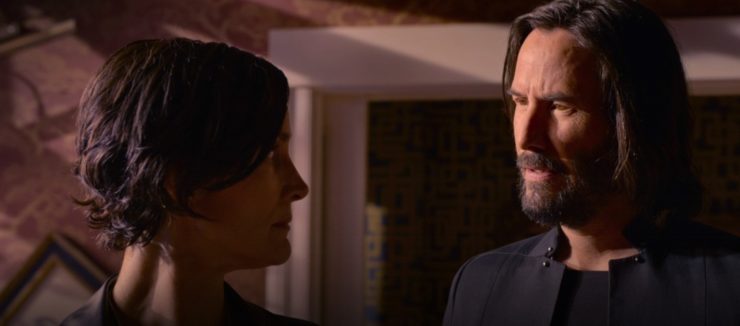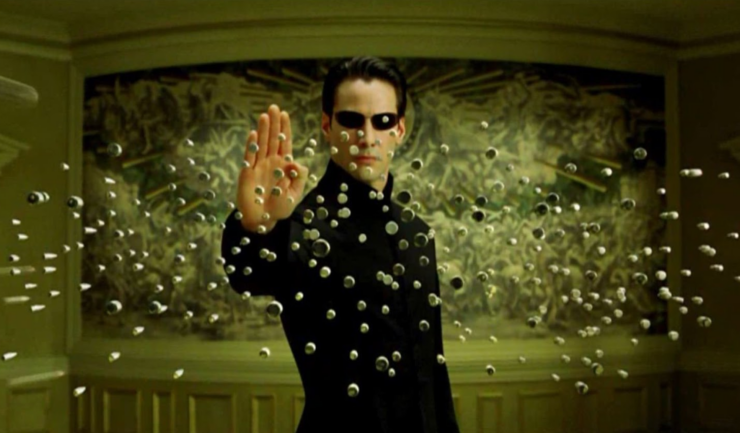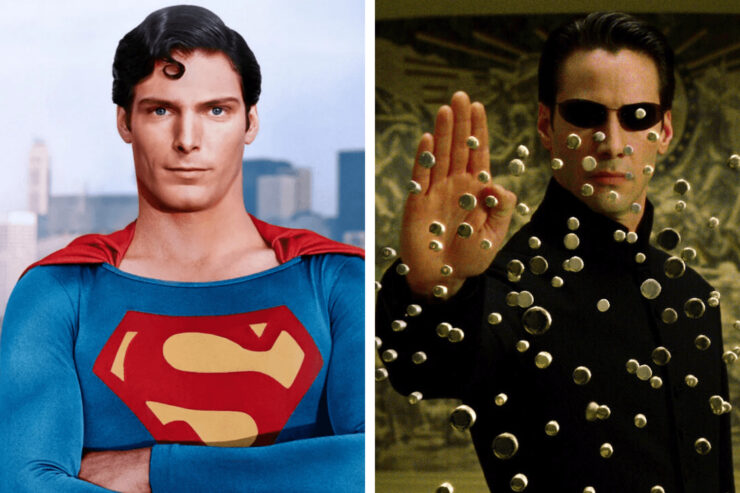If you pay attention to a certain sphere of film criticism, you’ve likely already come across analysis of The Matrix that couches it in the transgender perspective of its filmmakers: a story about unplugging from a world that forces you to live how it sees fit, the focus on Thomas Anderson’s transformation into Neo and the importance of seizing that change within himself, the continual pressure from outside forces (particularly in the form in Agent Smith) to literally “rebox” himself into the Matrix and take on the path that machine overlords have chosen for him.
All those who exit the Matrix choose new names for themselves, but its story belongs to “the One.” Neo’s declaration of his true name against Agent Smith’s constant droning to the tune of “Mr. Anderson” serves as an exegesis on intent, selfhood, and personal power. It’s hard to find a more potent or direct metaphor for transness than that. Neo is remaking himself in full view of the world: that’s what transitioning is.
But the first Matrix trilogy was missing something from that equation.
[Spoilers for The Matrix Resurrections.]
While Keanu Reeves is never the wrong person to build a story around, the Matrix trilogy was hampered by its reliance on the “chosen one” narrative, which makes for great drama, but hackneyed messaging. The idea that one special person can save all of us, that it’s on their shoulders alone, can be as trite as it is false—as much as it might appeal to modern individualism, no one saves the world alone. The Matrix films worked to show this to audiences by surrounding Neo with people who were more than ready to act for the future they wanted: Morpheus and Niobe, Captain Mifune, Zee and Kid, Sati, the Oracle, legions of people living in Zion, and of course, Trinity.
Trinity. The woman whose love and belief powered Neo through any number of struggles, through impossible battles and hardships. The woman who brought Neo to his destiny at the expense of her own life, and then his.
It’s not wrong for epic stories to end on a bittersweet trill, but losing Trinity that way could only be disappointing. She always seemed underserved despite showing her worth over and over again. And while Neo was something of a cypher as main characters go, Trinity’s sharp characterization seemed to fall away as the films continued. It never struck right.
So it’s only fair that she received a resurrection on par with Neo’s creation. One that put her on footing equal to his, and crystalized the transgender allegory within the Matrix narrative.
The Matrix Resurrections re-ups its transgender thematics first through Neo; he was the origin story, after all, and his remaking needs a little extra something in the construction. Once he makes the decision to take his new red pill and exit the Matrix once again, Bugs reveals that he’d stayed hidden from them for so long because his “DSI” was altered—his appearance, in layman terms. We see his reflection once or twice in mirrors and find out that to others in the Matrix, Neo looks entirely different.
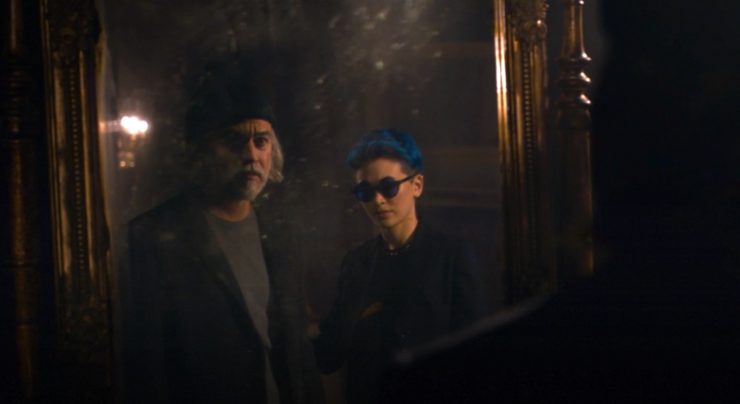
Let me reiterate: the Matrix system forcibly altered Neo’s image so that he would appear as someone he wasn’t. Specifically the image of a “balding old man,” an outward appearance that would be particularly resonant and difficult for an older generation of trans woman who didn’t have the ability or resources to transition in their youth (or possibly ever). Neo has been effectively closeted by the Matrix in a manner that very specifically denotes transness.
(As an interesting sidenote, Bugs saw through this illusion; she exited the Matrix years ago when Neo “attempted suicide” after a party for his hit video game—in actuality, he was attempting to fly again. Bugs was washing windows on the building and saw the real Neo, prompting her rescue from the system. This might indicate that Bugs herself falls somewhere under the trans umbrella, perhaps as a nonbinary person.)
When Neo is rescued again, he’s plugged into his old training ground with the new iteration of Morpheus, a program he created as a game designer to aid in his escape. Back in the dojo again, Morpheus puts him on “The One Fitness Plan,” telling Neo that he’ll have to fight if he wants to live… but Neo has decided that he’s done fighting. Morpheus proceeds to beat him savagely, but not without purpose. “They taught you good,” he says, pacing toward his bruised and bloodied friend. “Made you believe that their world was all you deserved.”
That thought can apply to any intersection of marginalized identities, but there’s a laser-focused quality to it from a trans perspective. The exhausting act of being trained to behave as your assigned gender from the moment you’re born and slapped into a color-coded onesie. The knowledge of those gendered expectations permeating all facets of existence. Life as a pretense, pretending to be someone you’re not every single day, and only for the comfort of others, even people you don’t know.
Neo eventually fights back, but not for his own sake. Morpheus finally plays his high card, that he knows precisely why Neo agreed to take the red pill when he appeared reticent: he wants Trinity back.
***
Neo saw her at his coffee shop almost daily inside the Matrix, a woman named “Tiffany” who had two children and the most familiar face he’d ever seen. After being awkwardly introduced to her via a tactless and vile coworker, the two eventually got coffee together. Tiffany admitted that she’d looked “Thomas” up after finding out that he was a famous game designer. She told him that she liked the character of Trinity from his game, that they had a love of motorcycles in common. Then she admitted that she showed the game to her husband, and asked him: Don’t you think she looks like me?
Her husband laughed at her.
“And I laughed too,” she tells Neo, “like it was a joke—how could it not be, right? Made me so angry. I hated myself for laughing. I wanted to kick him, so hard. Not too hard, maybe just… hard enough to break his jaw off.”
The pain emanating from that anger is cutting and so real—being dismissed by someone close to you will do that. Being made to think of yourself as a punchline. Being denied when you think you’ve found a true expression that fits your self-image. A moment later, Tiffany is interrupted by a phone call, and reaches into her purse. Neo looks down and catches her reflection briefly in the glare of the tabletop… and he sees a completely different person.

It’s then that you realize that Neo and Trinity have both been altered by the Matrix to appear different. Tiffany’s husband is laughing because the Matrix is working to deny her at each turn, but also because she genuinely doesn’t look like the video game’s Trinity to him. She looks like someone else. And it’s awful—or it would be, if this moment didn’t confirm something far more important:
Neo and Trinity can see each other. Exactly as they are.

In many ways, I think that there is no joy more clarifying than being a trans person in love with another trans person. Because they can see you, and you can see them. Because you both know how it feels when the world glosses you over, gilds you in trappings that ache more each day, and punishes you when you don’t fit. When you’re a trans person in love with another trans person, there is no need to act anything out. Physical transition or not, with hormone replacement or without, dysphoria raging or mercifully quiet, it doesn’t make a whit of difference: they will always see the person you want to be.
And Neo can see Trinity. And she can see him.
***
Neo eventually learns how he and Trinity were resurrected in a talk with the Analyst, who explains how this new Matrix is balanced. The Analyst quickly found that keeping Neo and Trinity together led to disaster for his plans—but too far apart was an equally dangerous situation. Instead, he learned to keep them close, but never together: in each other’s periphery, but never near enough to touch.
The humans on the outside read Trinity’s code and find her to be pure “blue pill.” They’re worried she won’t make the choice to leave the Matrix, and it’s a choice they’ll have to respect, even if they enact their elaborate rescue plan. Lexi takes a quiet moment to ask Neo if perhaps the old Trinity is gone for good, and Neo replies: “I never believed I was The One. But she did. She believed in me. It’s my turn to believe in her.”
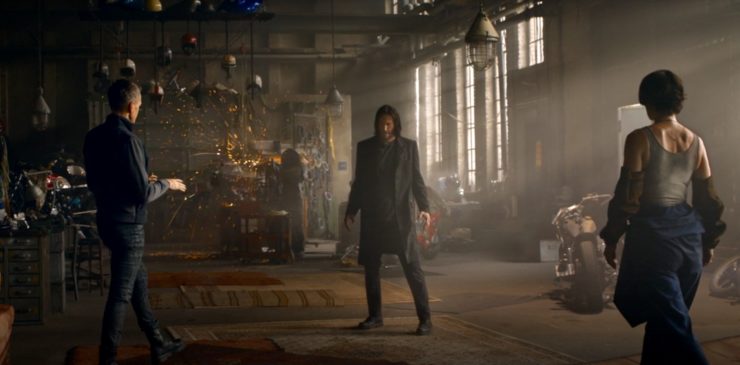
The differences in Neo and Trinity’s journeys illustrate two distinct and common roads to transness: Neo doesn’t feel safe or powerful enough to claim ownership of himself. He needs the belief and love of others to find his power, but even then, it’s perhaps not as difficult as he’d like to shove him back into the program. Neo never quite believes that he lives up to that image he wants for himself. (And Trinity has always believed, of course, because Trinity can see always see him.) For Trinity, it’s less about safety or belief, and more about that niggling, gritty, horrifying feeling that something is wrong. She doesn’t remember choosing her life. She doesn’t see who other people see when they look at her. She doesn’t like the sound of her own name.
At one point, Neo tries to call her Trinity before she’s ready, and she replies, “You shouldn’t call me that.”
Not that she doesn’t want him to. But he shouldn’t.
Neo gets one chance to rescue the love of his resurrected life, and the choice lies with her. She sits with him at the same coffee shop table, and he tries to explain that the game he wrote was real, that they are the characters within it. She admits that she feels like she has been waiting her whole life for him, and wonders what took him so long. He tells her that he’s not sure, that maybe he was afraid of this very scenario, one that could end with him losing her.
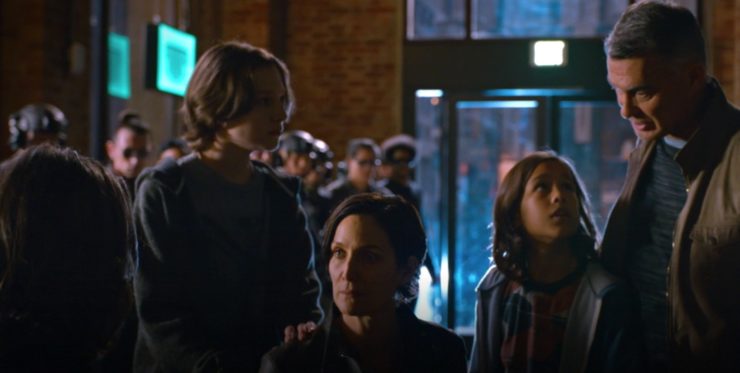
Like clockwork, the program kicks in hard, and Tiffany’s family come to retrieve her; their dog was hit by a car, and the dog was hit chasing after her. They drag her away, toward the door of the coffee shop, and she follows, unable to conceive of the reality where she is that person she longs to be so badly. But then she looks back to see Neo laid out before a firing squad as her husband begins shouting—she isn’t listening, so he calls to her. Tiffany, you have to come with us.
And there’s the breaking point: hearing that damn name one more time.
“I wish you would fucking stop calling that,” she gasps. “I hate that name. My name is Trinity. And you better take your hands off of me.”
The catharsis of that declaration is something that many trans people know intimately. And there are layers here for Trinity that Neo never had first time around; she is railing against the physical dysphoria of being seen as an entirely different person and being implicitly aware of that fact, of being a wife and mother when she never agreed to those roles, of being inundated with run-of-the-mill sexism every day. She is fighting against those rules and parameters because she knows something is wrong with the world she sees… but also because he believes in her.
The Analyst knew they couldn’t be left together. Because if transness is this powerful on its own, how much more powerful will it be to the power of two?
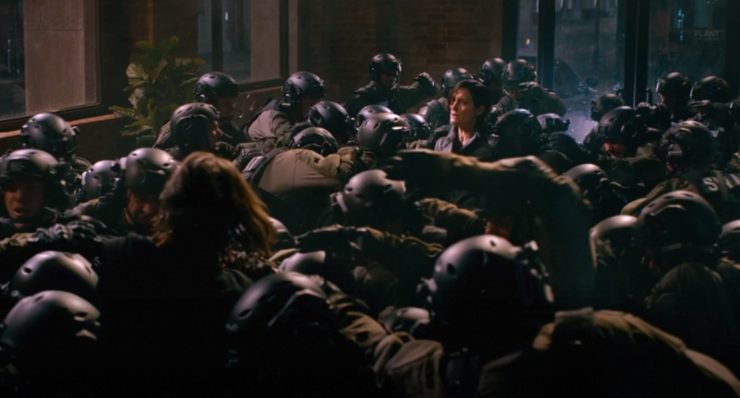
It’s different this time. We’re not waiting for Trinity to dodge bullets—we’re waiting for her to reach Neo. The two of them fight their way toward each other, surrounded by a sea of SWAT cops that the Analyst hopes will hold them at bay. When they touch, light explodes all around and everyone is thrown aside… except for them. The fight isn’t over, so they hop on Trinity’s motorcycle to escape. Neo uses his newfound powers to shield them from everything the Matrix throws. And when it looks like they’re cornered on a rooftop, with Neo’s powers of flight still nowhere to be found, they make the choice to jump off the building anyway.
And it turns out that Trinity could fly this whole time, too.
The Matrix Resurrections is a movie about a lot of things. But if you think there’s any conceivable reality in which one of those things isn’t Neo and Trinity’s trans love saving the world? There’s nothing I can do for you. You’re taking the blue pill, sweetie.
“We can’t go back,” says Trinity of the Matrix and their lives within it, looking out over a city that doesn’t exist.
And Neo promises: “We won’t.”

And The Matrix Resurrections takes the story of The One and makes it about two, about transformation and rebirth, and most importantly, about how it feels to be in love with someone who sees you… exactly as you truly are.
Emmet Asher-Perrin isn’t saying that this movie came out in the exact moment that they needed it, but they’re not not saying that. You can bug them on Twitter, and read more of their work here and elsewhere.










